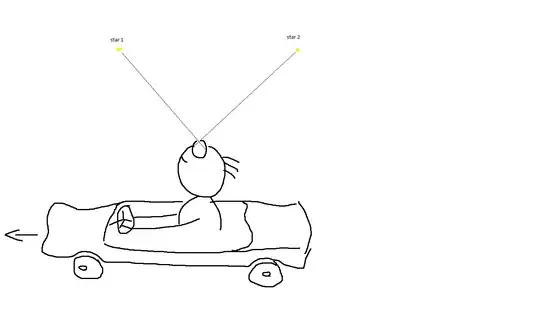You are moving with high speed on a road on earth and are looking at the night sky, in particular at two stars.
From a somewhat practical point of view, even the speed of any (section of) road itself, on Earth's surface, with respect to a non-rotating quasi-inertial frame which is momentarily comoving with Earth's center) is comparatively high compared to typical speeds of cars "going really fast" wrt. the road surface (except for road section in "high polar regions" of Earth);
and even more so the speed, namely roughly 30 km/s of any (section of) road on Earth's surface wrt. the non-rotating quasi-inertial frame which is comoving wrt. the center of the Sun.
[...] But because the position of the dots on your retina (or more specifically, the cells that are excited by starlight)
... it is certainly correct and useful to be just as specific about the concrete identifiable constituents (a.k.a. participants) of the setup under consideration ...
are independent of the frame of reference,
That's (bordering on being) incorrect, and consequential misleading.
Recall W. Rindler's dictum that
"An inertial frame is simply an infinite set of point particles sitting still in space relative to each other".
In this sense, the set of starlight-collecting cells in (or rather, making up) the retina of the driver you described constitutes itself a (small, or at least partial) particular frame of reference.
you also observe a distance between the two stars that is greater than the other observer.
That's (bordering on being) incorrect. No: distances or not ("plainly") observed, but distances, or more specifically: ratios of distances, are measured (in ideal cases, including thought experiments); or, in more practical circumstances, distance ratios are estimated (usually accompanied by a quantitative stateent, or at least a qualitative discussion, about the range of confidence of the estimate).
This is especially relevant when understanding "length contraction" as referring to the measured distance ratio between certain pairs of participants who belong to different (inertial) reference frames which move (uniformly) wrt. each other;
in Einstein's popular example specifically the distance ratio between
the distance (A'B') of two specific identifiably constituents, A' and B', of a train (which moves with some speed v on a railway embankment) and
the distance (AB) of two specific identifiably constituents, A and B, of the railway embankment, which are identified (in rlation to train constituents A' and B') by the requirement that the (clock) indication of A at the passage of A' is simultaneous to the (clock) indication of B at the passage of B'.
It can be shown and has been shown that this specific distance ratio, (A'B') / (AB), has the value $\frac{1}{\sqrt{1 - (v/c)^2}}$; cmp. for instance eq. $(1\rm d)$ in this derivation.
